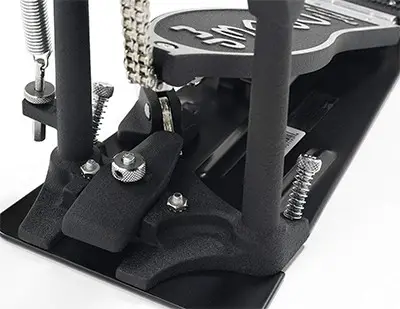
Having owned a few double bass drum pedals over the years, I’ve learned a fair amount about how to properly set them up in the traditional sense as well as some unique and creative ways to use them to play other instruments.
The traditional setup is to attach the primary pedal to the bass drum as you would a single pedal and to place the second, slave pedal just to the right of the hi hat stand’s pedal board. There are other uses for these pedals to play other percussion instruments, with similar set up methods.
In this article, I am going to go into detail on both the traditional setup as well as a fair amount of unique use case setups which you are likely to encounter. You might even get a few ideas for new ways to set your kit up!
Tips For Setting Up Your Double Bass Drum Pedal
First, let’s cover a bit of terminology. As the name suggests, double bass drum pedals have two separate pedals, only one of which has the bass drum beaters and spring assemblies attached to it.
To keep things straight, these two pedals are referred to as the ‘master’ and ‘slave’ pedals, much like the master and slave cylinders in a car’s brake system. The master pedal is the one containing all spring assemblies as well as both beaters. The slave pedal is merely a pedal board, sometimes with its own spring assembly as well.
The adjustable metal rod connecting the two pedals is commonly referred to as the drive shaft. These drive shafts are relatively interchangeable between brands and are therefore easily replaceable. The drive shaft connects to each pedal with a female/male square shaped connector and the length of the shaft can be adjusted and locked in with a standard drum key.
With the terminology out of the way, let’s talk through the practical steps for setting up your double pedal:
1 – Attach the Master Pedal
Attach the master pedal to the bass drum in the usual way. Most pedals clamp to the bass drum hoop via a mechanism called a toe clamp and is operated by a wing nut.

2 – Test and Adjust the Master Pedal
Once you’ve attached the pedal, you’ll want to go ahead and test the master pedal’s functionality by playing a bit. If necessary, make any adjustments to the relevant spring assembly so that the action of the pedal is to your liking.
3 – Hi Hat/Snare Setup
Before you get any further, you’ll want to make sure that your hi hat stand and snare drum are properly positioned to your liking. The reason to do this before completing the double pedal setup is that I generally don’t like to sacrifice the placement of my hi hat and snare in order to make a bass drum pedal work. So – place these two items where they feel comfortable.

4 – Place You Slave Pedal
Now, go ahead place your slave pedal to the right of your hi hat pedal so that you can easily switch your left foot between the two pedals. NOTE: without the connection between the two pedals, there will be no tension on the slave pedal at this time and the foot plate will be on the floor.
5 – Connect the Slave and Master Pedals
With your slave pedal in the desired position, go ahead connect the two pedals with the drive shaft. To do so, you’ll want to first loosen the length adjustment screws so that it can be easily adjusted. Then, connect one end to the master pedal. After that, go ahead and position the slave pedal in the ‘up’ position and connect the drive shaft to it, locking the pedal in the up position.
6 – Test and Adjust the Slave Pedal
Just as you did with the master, go ahead and play with the slave pedal a bit and make any necessary spring adjustments to make the pedal playable.
Other adjustments you may need to make include the bass drum beater height (to ensure you are striking the center of the drum head), pedal board spike deployments (to keep the pedals in place) and the cam position. This cam dictates the resting height of the slave pedal board when connected to the master via the drive shaft.
Slave Pedal Slide: Without being properly anchored, the slave pedal especially has a tendency to move forward when being played. The spikes in the pedal board should help with this, however sometimes additional anchoring may be required. I wrote a full article on how to keep your bass drum from sliding forward , which has useful information for anchoring a slave pedal as well.
, which has useful information for anchoring a slave pedal as well.
Ideal Slave Pedal Positioning
As mentioned in step four above, you’ll want to position your slave pedal assembly as close to the hi hat pedal as possible. The pedal boards’ top and bottom should align so that your foot can easily switch between each board’s optimal playing position.
Additionally, special attention should be payed to the cam adjustment in step 6 above. This allows you to set the height at which the slave’s pedal board rests when not being played, without impacting the resting position of the beater over on the master pedal. The height of this pedal board should fulfill two basic criteria:
- Ensure the playing position of the board is comfortable for you and your playing style. Too low and you could ground out the pedal. Too high and the spring tension may be too much.
- The height of the slave pedal board and the hi hat pedal board should match each other to ensure smooth transition between the two instruments with your left foot.
Playing Other Percussion Instruments With Double Pedals
It is not uncommon to see a double bass drum pedal (or a single pedal for that matter) with the master attached to a mounted percussion instrument on the floor. Typically this is something like a cowbell or a tambourine.
Doing this with a double pedal allows for remote placement of the instrument in your setup as to not interfere with the placement of your primary stands.
An additional mounting bracket is required for this sort of setup, much like this Gibraltar cowbell mount , which includes a lip onto which the bass drum pedal can be attached. Notice also the inclusion of retractable spikes for traction on carpeted surfaces.
, which includes a lip onto which the bass drum pedal can be attached. Notice also the inclusion of retractable spikes for traction on carpeted surfaces.
Remote Bass Drum Setup
If you’ve spent any time Googling unique and large drum sets, it is very likely that you’ll have encountered a setup with a remote bass drum (i.e. one which isn’t directly in front of the drummer). This could be a second (or third/fourth) bass drum or a primary bass drum which isn’t being played in front of the drummer.

Probably one of the largest and most famous large setups is that of Terry Bozzio, who is known for very complex polyrhythmic playing and the chromatic tuning of his toms. The sheer number of drums in his kit is staggering, but equally so are the number of bass drum pedals, hi hat pedals, remote hi hat pedals, double bass drum pedals and remote bass drum pedals he employs (see the picture to the right).
Terry’s kit features your standard double bass drum setup in front of him, but he also has a pretty large number of other instruments, including bass drums set up remotely and played via a double pedal.
This is relatively simple to accomplish as you are still just attaching the master pedal to the remote bass drum (albeit with only one beater attached) and using the slave to actually incorporate into your playing position to play the instrument. Cool!!!
Now while the Terry Bozzio example is a bit extreme, it goes to show that you are only limited by your imagination, and perhaps funding for how creative you can get with your pedals. Whether you decide to play additional bass drums, hi hats, cowbells, gong drums or toms with your feet…there’s a solution out there for you. But probably the most attainable and easy solution is to utilize a double bass drum pedal to just play with setups and have fun experimenting!
Related Questions
How do I keep my bass drum from sliding forward? I’ve actually written a detailed article answering this exact question in detail, but generally speaking – you’ll likely want to get a drum rug and some additional method of anchoring your bass drum or pedal to the rug.
How do I muffle my bass drum? There are many methods available to muffle a bass drum, however the most common by far is to take a pillow or blanket and place it inside of the drum to where it touches both batter and resonant heads. Have a port (or hole) in the resonant head is handy so that you can position the muffler of your choice.
